Rehabilitation isn’t just about getting your body to move again. It’s also about getting your mind to focus, to adapt, and to stay sharp. After limb loss, people often focus entirely on physical recovery—how to walk, how to lift, how to use a prosthetic. But behind every movement is a brain working hard to rewire itself. That brain needs just as much care as the muscles.
This is where gamified rehab brings something very special to the table. It doesn’t just help people move better—it helps them think better. It strengthens attention, sharpens focus, and improves coordination in ways traditional rehab often overlooks. And it does all of this using a method that doesn’t feel like therapy. It feels like play—with a purpose.
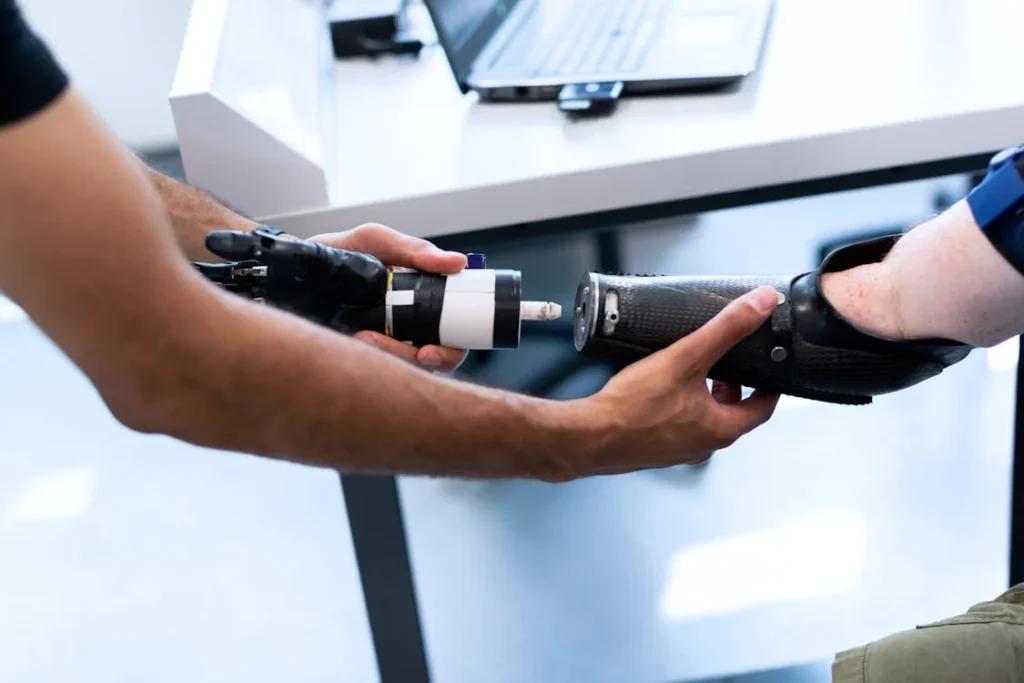
How Movement and Focus Work Together in Rehab
Relearning the Connection Between Brain and Body
Every physical movement begins in the brain. Before your arm lifts or your leg steps, there is a message—an instruction—sent from your mind to your muscles. After limb loss, that connection can feel broken. Even with a prosthetic in place, it takes time for the brain to trust the new movement. It’s not just the body learning a task—it’s the brain learning to believe in the body again.
This is where cognitive focus comes into play. When someone starts rehab, especially with a new limb or assistive device, they’re not just trying to move—they’re trying to think through every movement. “Is this the right angle?” “Am I putting too much weight?” “Is the prosthetic responding?” These thoughts crowd the mind and can quickly lead to fatigue or frustration.
Gamified rehab helps filter out that noise. By giving the user a task—one that feels purposeful but not overwhelming—it brings focus to just one thing at a time. Instead of thinking about every joint and step, the user concentrates on collecting a virtual object or following a light trail. This shifts the brain from stress to engagement. It creates what psychologists call flow—a state of focus so natural that movement becomes smooth again.
Why Traditional Exercises Often Fail to Hold Attention
Many rehab routines are made up of repetitions. Do this motion ten times. Hold this pose for thirty seconds. Repeat. While these movements are necessary, they lack stimulation. The brain, especially after injury or surgery, is looking for meaning. It wants to know why this task matters. When it doesn’t find that meaning, focus fades.
That’s when mistakes happen. Users zone out. Their posture collapses. They forget to activate the right muscles. And slowly, their body picks up bad habits—what clinicians call “compensatory patterns”—that can actually make recovery harder in the long run.
Gamified rehab keeps the brain locked in. It’s not just a visual on a screen—it’s a puzzle. A mission. A race. A rhythm. These experiences are not random. They’re designed to light up the areas of the brain responsible for attention, memory, and coordination. When someone is guiding a glowing ball through a maze or mimicking patterns on a virtual drum, they aren’t just exercising—they’re building cognitive skills while moving.
The Science of Focus in Gamified Environments
When you’re deeply focused, something interesting happens inside your brain. Distractions fade away. Your senses sharpen. Your movements become more precise. In brain scans, scientists see increased activity in the prefrontal cortex—the area responsible for decision-making and attention. The cerebellum, which helps control balance and coordination, also lights up. These areas are the foundation of smart, stable movement.
Gamified rehab activates these areas again and again. It keeps users focused not because it forces them, but because it draws them in. The use of color, sound, motion, and reward creates a kind of mental gravity. People want to stay present. And the more they stay present, the more efficiently their brain rewires itself to support better control and coordination.
This is especially helpful for older users or those recovering from stroke, nerve damage, or traumatic injury. Their minds may wander more easily. They may tire faster. Traditional rehab may overwhelm them. But a well-designed game adapts to their pace, keeping their focus active without overloading them.
At Robobionics, we’ve seen users who could barely concentrate for five minutes go on to complete twenty-minute rehab sessions through game platforms—completely focused, completely engaged. That’s the power of design that respects the brain.
Coordinated Movement Comes From Consistent Attention
Let’s talk about coordination. People often think of it as balance or timing. But really, coordination is about communication. It’s your brain sending clear signals to multiple parts of the body—quickly, precisely, and in the right order. It’s what helps you walk in a straight line, tie your shoelaces, or carry a cup without spilling.
After limb loss, coordination becomes harder because the brain has to send signals to unfamiliar parts—like a new prosthetic. The signals may be hesitant at first. Delayed. Weak. That’s normal. But to improve coordination, you need one thing above all else: focus. Because if your attention slips, even a strong muscle won’t know when to fire. Even a well-fitted prosthetic won’t move right.
Gamified rehab builds this attention over time. The tasks require both thought and movement. Reach here. Tap this. Avoid that. React fast. These aren’t just instructions—they’re mini coordination drills. They train your brain to stay alert and make decisions in motion. And the best part? Users don’t even realize they’re training coordination—they’re just having fun.
But underneath that fun is something powerful: the rewiring of reflexes, the sharpening of timing, and the rebuilding of trust between mind and movement.
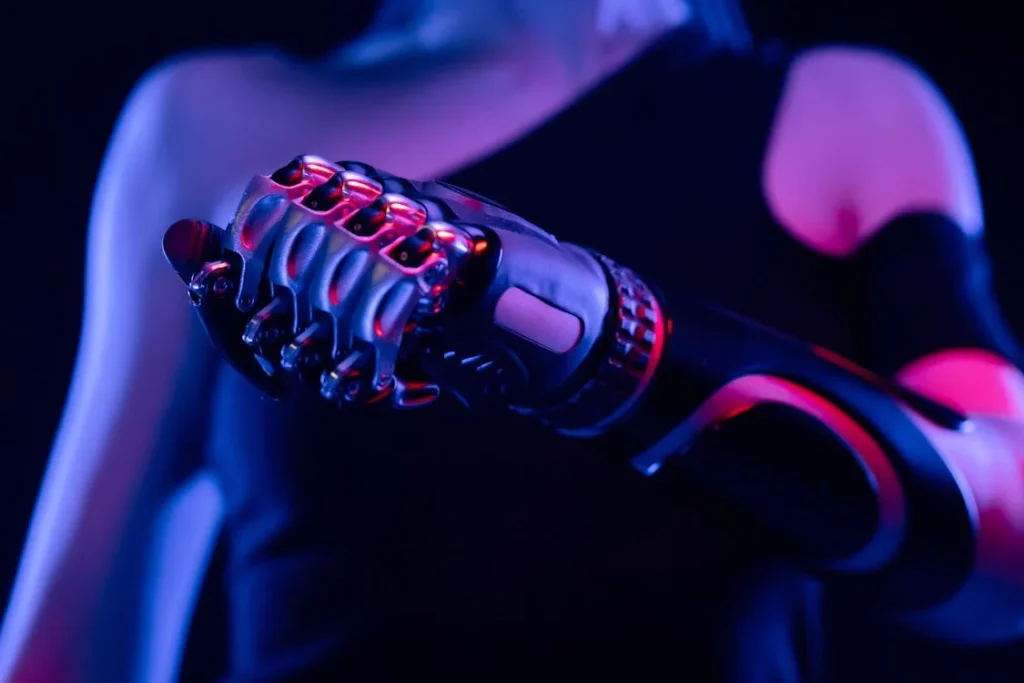
How Gamified Rehab Rewires the Brain for Long-Term Focus
Neuroplasticity: The Brain’s Ability to Adapt Through Play
The human brain is not fixed. It changes based on what you do every day. This ability to adapt and form new pathways is called neuroplasticity. After an amputation or injury, the brain needs to re-learn how to interact with the body—how to command a prosthetic, how to sense balance, how to stay safe in motion. This doesn’t happen overnight. It takes repetition, feedback, and above all—attention.
Gamified rehab helps create the perfect environment for neuroplasticity. It combines movement with meaning, which tells the brain: “This is important. Pay attention. Store this.” When users play a rehab game, they’re not only activating muscles—they’re also strengthening the pathways between neurons. The more these pathways fire, the more stable and automatic they become. Over time, what was once awkward and forced becomes natural.
And here’s what’s exciting—neuroplasticity thrives on novelty. That means when tasks are slightly different each day, when they include sounds, visuals, surprises, and rewards, the brain responds faster. This is where gamified systems outperform repetitive rehab drills. They provide the same foundational training—but layered with variety and feedback that keeps the brain engaged.
For example, a user playing a motion-based rehab game might reach for targets that change color and position. Each new level challenges reaction time, memory, and coordination, keeping the brain in a learning state. As those pathways strengthen, so does the user’s confidence and ability to focus.
Reducing Mental Fatigue Through Immersion
Rehab is not only physically tiring. It’s mentally draining, especially for new amputees or older users who are still adjusting to the emotional and cognitive load of recovery. Mental fatigue often shows up as brain fog, impatience, zoning out, or forgetting instructions. This fatigue builds up when exercises are long, repetitive, and uninspiring.
Games can help counter this by creating immersive focus. When the brain is immersed in an engaging task—something that feels like play, not work—it uses energy more efficiently. Instead of spending effort just trying to stay interested, the brain locks into the task, allowing attention and energy to go where they’re needed: into movement, memory, and control.
This is why a 15-minute rehab game can feel easier—and produce better results—than a 15-minute paper-based task. It’s not about how long you work. It’s about how deeply you’re focused during the work.
We’ve observed at Robobionics that users who struggle with attention during in-clinic rehab often perform better with game-based systems at home. The structure of the game removes external distractions. It pulls the user in. That immersion becomes a form of mental rest—while still allowing for physical progress.
Training Dual-Tasking: Thinking and Moving at the Same Time
In daily life, we rarely just move. We walk while talking. We reach while thinking. We balance while planning our next step. These are called dual-task activities—when the brain has to coordinate physical movement and cognitive thinking at the same time. After limb loss, dual-tasking becomes harder. The brain is so focused on just moving that it struggles to do anything else.
That’s a problem, especially when rejoining real-world activities like walking through crowded places, crossing streets, or working in the kitchen. It’s not enough to move well in a quiet room—you need to move well while thinking.
Gamified rehab builds this skill naturally. Many games require users to remember sequences, react to changing colors or sounds, or make decisions while performing physical tasks. These challenges mirror real-life dual-task demands, and they train the brain to split its attention without getting overwhelmed.
Take, for example, a game that involves stepping in time with music while choosing the correct direction on a screen. The user must move, focus, and decide—all at once. At first, it’s difficult. But with repetition, the brain adapts. Coordination improves. Focus sharpens. And slowly, that ability to dual-task begins to return.
This kind of training is hard to replicate in traditional rehab. It requires structure, feedback, and progressive challenge—all of which games are built to deliver.
Encouraging Consistency Through Mental Satisfaction
Focus and coordination only improve with consistent practice. But let’s be honest: most people don’t feel excited about repeating the same exercises every day. They might start strong for a few weeks, but as the novelty wears off, their attention fades. They begin skipping sessions. Progress slows.
Gamified rehab solves this by offering a steady stream of mental rewards. Not just points or levels, but emotional rewards: curiosity, surprise, pride, and momentum. These feelings are powerful drivers of habit. They make people want to return—not because they have to, but because they want to see what happens next.
Each session becomes a small adventure. Even if the movement is similar, the context changes—the visuals, the challenge, the pace. This keeps the brain interested. And when the brain is interested, it stays focused. And when focus stays, progress follows.
This consistency is where real transformation happens. Not through intensity, but through attention over time. That’s the secret.
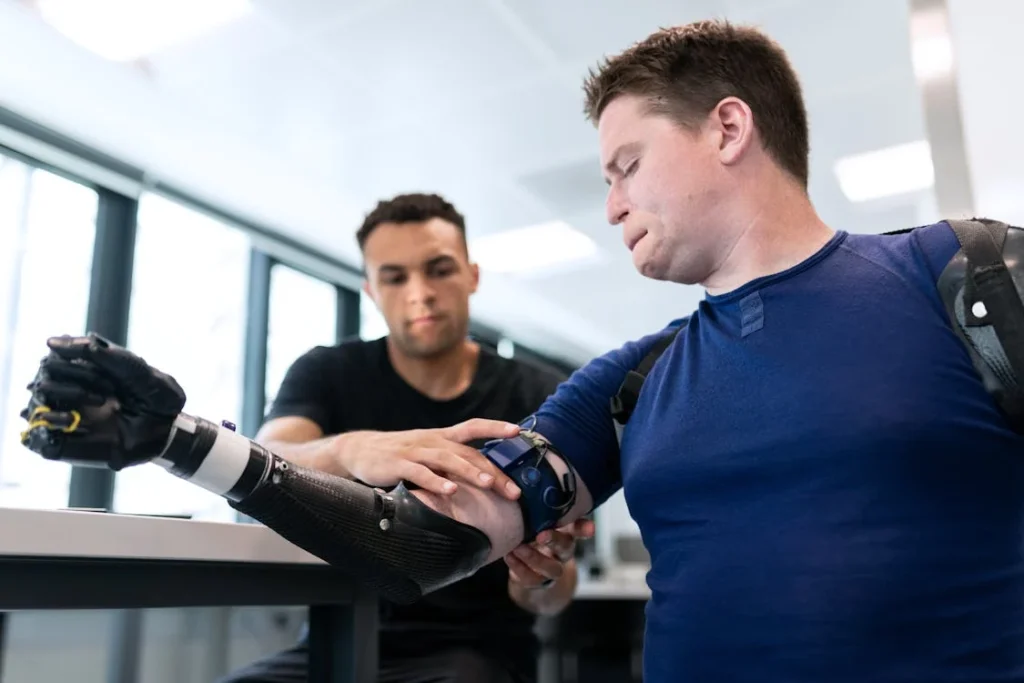
The Role of Visual and Auditory Cues in Strengthening Focus and Coordination
Why the Senses Matter More Than We Realize
Every movement we make is guided by signals from the outside world—what we see, what we hear, what we feel. After limb loss, these sensory signals often feel confusing or incomplete. The brain is trying to rebuild a map of the body, but that map needs input. Without clear feedback, even simple movements can feel disconnected or clumsy.
Gamified rehab provides the input the brain craves—clear, timely, and structured sensory feedback. That’s where visuals and sounds come in. These aren’t just extras in a game. They are powerful tools to sharpen focus and fine-tune coordination. They help the user link thought and action in real-time.
In our work at Robobionics, we’ve seen how users respond almost instantly to well-designed cues. A glowing path on the screen shows them where to move. A soft ding confirms success. A rising tone tells them they’re getting closer. This multi-sensory feedback keeps them locked in—and more importantly, it gives the brain proof that its commands are working.
That confirmation builds confidence. And confidence, as we know, is the starting point of control.
Using Visual Targets to Improve Accuracy
Visual cues help guide attention. When a person is told to “lift your leg” or “reach to the side,” the instruction is open to interpretation. But when they see a bright target appear at a specific height and distance, the brain understands exactly what to aim for. That level of clarity is what helps users improve accuracy and consistency.
In gamified rehab, this could look like tapping colored dots on a screen using a prosthetic hand, or moving a cursor using upper limb gestures. As targets change position or color, the user’s brain must quickly recognize the change, make a decision, and execute a movement. That’s not just motor training—that’s cognitive targeting.
This direct feedback loop between what you see and how you move refines both focus and coordination. Over time, the movements become smoother, quicker, and more natural. The visual environment trains the eyes to stay alert and the brain to keep directing the body with precision.
In some cases, visual distractions are even added on purpose—to test how well the user can focus while filtering out noise. This helps simulate real-world situations like walking through a crowd or reacting to a fast-moving environment. The game becomes more than rehab—it becomes a simulation for life.
How Sound Guides Timing and Control
Auditory cues are equally powerful. In fact, the brain often responds faster to sound than to sight. That’s why sound is used so effectively in games—to guide timing, build rhythm, and reward correct actions. A well-timed sound can turn a movement from stiff to smooth. It creates a sense of flow.
In rehab, rhythmic sounds are often used to pace walking or hand movements. But in gamified platforms, those sounds are tied to success. For example, completing a movement in time with a beat or pressing a button in sync with an audio cue. This builds timing and reaction speed—not just at the physical level, but within the brain’s motor planning system.
Think about a simple game where you move your prosthetic hand to match drum beats on a screen. The brain must match the sound with a motion, in real time, again and again. That strengthens both focus and motor timing. The rhythm helps the brain predict the next step. And when users “feel” the movement rather than just “think” it, their control becomes automatic.
Even small differences in sound pitch or duration can guide the user toward better form. A short beep may signal incorrect posture. A longer tone may indicate success. Over time, these sounds become part of the user’s internal feedback system. They don’t need a coach to tell them when they’ve done well—their brain already knows, because the game has taught them how to listen for it.
Combining Cues for Stronger Engagement
The real magic happens when visual and auditory cues work together. A light flashes. A sound plays. A target appears. This multi-sensory combination lights up the brain in multiple areas at once. It makes learning faster, deeper, and more lasting.
This kind of engagement is critical for people recovering from complex surgeries, neurological trauma, or stroke-related limb loss. Their brains may be slower to process single types of input—but when cues come in through multiple senses, it helps bridge the gaps. It reinforces the message.
At Robobionics, we’ve partnered with developers who understand this well. The best rehab systems we’ve used with clients balance both types of cues—using just enough input to create immersion without overwhelm. When it works, it’s remarkable. Users forget they’re doing “therapy.” They’re just playing a game—and getting sharper with every movement.
And behind the scenes, the brain is doing what it does best: adapting, wiring, focusing, learning.
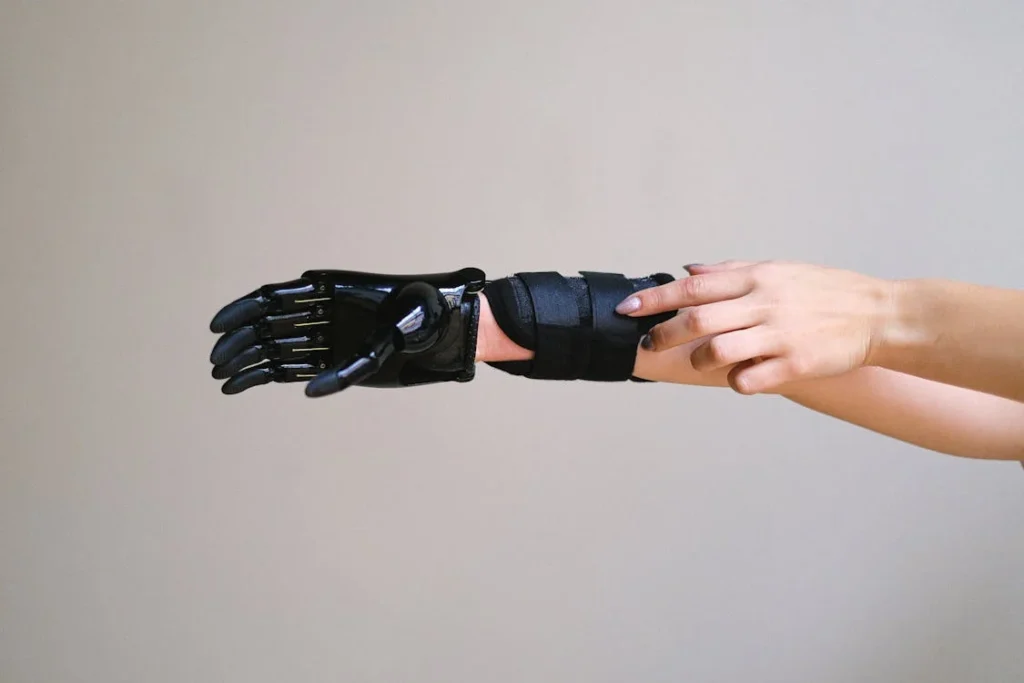
Gamified Rehab as Mental Exercise: Beyond Physical Recovery
Why the Brain Benefits Even Without Full Movement
Not all recovery happens in motion. In fact, a large part of rehabilitation starts in the mind—before the muscles engage, before the prosthetic responds. This is especially true for users who are at the beginning of their recovery, or who may be temporarily limited in what their bodies can do. The good news is that gamified rehab doesn’t require perfect physical performance to activate the brain.
Even passive interaction with rehab games—watching, imagining the movement, planning the response—stimulates vital cognitive systems. This is a technique known as mental rehearsal, and it has long been used by athletes and stroke survivors. Simply visualizing a movement can strengthen neural connections involved in that motion. Now, with gamified platforms, users can take this one step further by interacting with real-time challenges that activate thinking, decision-making, and memory.
In short, gamified rehab becomes mental exercise. It trains focus, boosts problem-solving, and supports long-term recovery, even when the body isn’t fully ready. That makes it one of the most inclusive tools available in the rehab space—beneficial not just for the body, but for the mind too.
Strengthening Working Memory Through Game Mechanics
Working memory is your brain’s ability to hold and use information for short periods of time. It helps you remember what you were just told, keep track of steps, or follow instructions. After limb loss, especially when accompanied by trauma or surgery, working memory can take a hit. People may forget sequences, lose track of tasks, or feel overwhelmed by even small instructions.
Many rehab games address this without making it obvious. They ask the user to remember a pattern, react in a sequence, or repeat a movement shown earlier. These tasks aren’t labeled as “memory training”—they’re just part of the game. But they’re working behind the scenes, helping the brain organize, store, and retrieve information faster.
For example, a game might show three glowing targets in a row, and then ask the user to repeat them using hand or arm gestures. It sounds simple, but it activates key areas of the brain involved in memory and planning. The result? Users don’t just move better—they think more clearly. They become better at tracking tasks, following instructions, and staying mentally organized in everyday life.
Boosting Cognitive Flexibility With Adaptive Challenges
Cognitive flexibility is the brain’s ability to shift between different ideas, tasks, or movements. It’s what helps you adjust when plans change, or when something unexpected happens. For prosthetic users, this skill is crucial. They need to switch between mental modes—thinking, reacting, adapting—all while maintaining balance and control.
Gamified rehab is one of the best ways to train this flexibility. The games constantly introduce new patterns, goals, and rules. A target that was safe yesterday may now be a hazard. A movement that worked before might now need adjustment. This forces the user to stay alert, change strategies, and respond quickly.
Unlike static rehab routines, which can become automatic and dull, gamified systems require active thought. And that mental effort pays off. Over time, users become faster at switching focus. They stop hesitating. They become more agile—not just physically, but mentally.
This mental agility is what helps people handle real-world unpredictability. Whether it’s navigating a busy market or responding to a sudden balance shift, their brain has been trained for the unexpected—through a game.
Encouraging a Growth Mindset Through Play
One of the most overlooked benefits of gamified rehab is how it changes the user’s mindset. In traditional rehab, failure can feel heavy. You try to lift your arm—and it doesn’t move. You try to walk—and you fall. These moments hurt. They create frustration, doubt, and even shame.
Games reframe failure as feedback. If you miss a target, it’s not personal. It’s part of the process. You try again, and the game encourages you. You level up, even if you don’t win right away. That repetition—without judgment—teaches users something incredibly valuable: progress is built on patience. And every mistake is a step forward.
This is what’s known as a growth mindset. It’s the belief that abilities can improve with effort, that mistakes are opportunities, and that setbacks are not the end of the road. Gamified rehab teaches this mindset naturally, simply by the way it’s structured.
At Robobionics, we’ve seen users who were afraid to try new movements slowly gain confidence through games. They stop saying “I can’t” and start saying “I’ll try again.” That shift in language signals a deeper shift in identity—from passive patient to active participant.
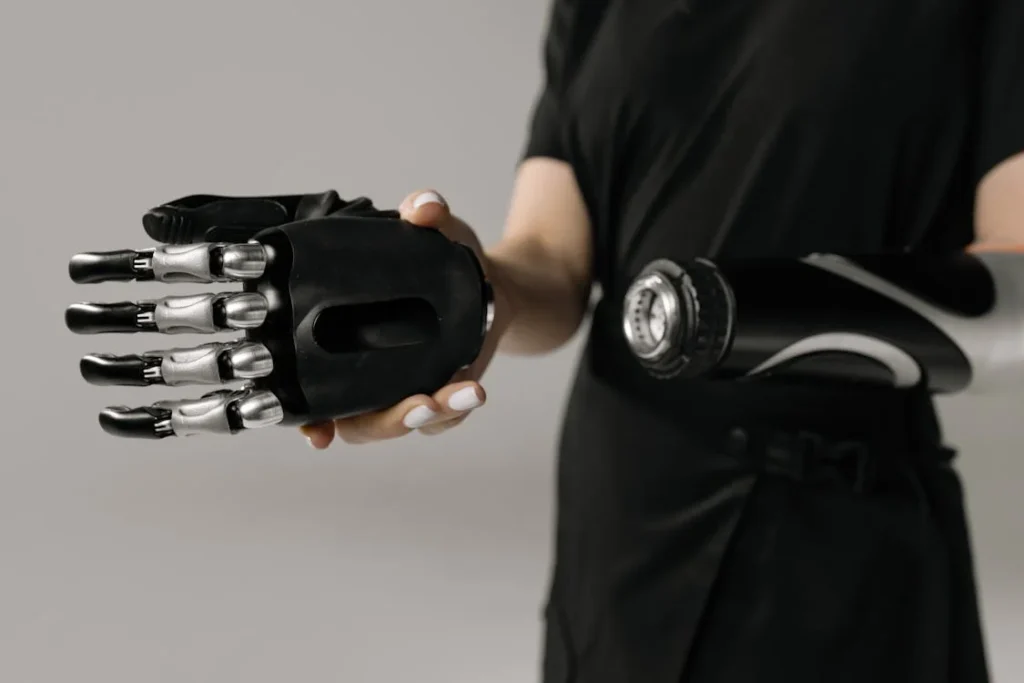
Training Reaction and Decision-Making Through Interactive Rehab
Why Split-Second Choices Matter in Everyday Mobility
Walking across the street. Catching yourself from a stumble. Adjusting to an uneven surface. These everyday movements all require one thing in common: quick, confident decisions. For people using prosthetics—especially for those newly fitted—these moments can be tricky. The brain is still processing how to move with a new limb. And when something unexpected happens, hesitation can be dangerous.
That’s why reaction time isn’t just a “bonus skill.” It’s critical for safety and independence. The faster and more accurately your brain can interpret a situation, choose a response, and activate a physical movement, the more confident—and protected—you are in the real world.
Gamified rehab builds this very ability, often without the user even realizing it.
How Game Mechanics Build Rapid Responses
In gamified rehab, the system constantly presents new challenges. A light flashes and the user has to move. A sound changes, signaling a different action. A virtual object speeds up, and the user must shift directions quickly. These moments simulate real-life unpredictability—except they do it in a controlled, safe environment.
This form of training is incredibly powerful for teaching the brain to scan, decide, and act. These are the three core steps behind every reaction:
- Scan: Your senses detect a change—visually, aurally, or spatially.
- Decide: Your brain interprets the situation and selects a response.
- Act: Your body (or prosthetic) performs the chosen motion.
The more often this sequence is practiced, the faster and more automatic it becomes.
Traditional rehab tends to focus only on the “act” part—moving correctly. Gamified rehab, however, includes the entire sequence. That’s what makes it such a valuable tool for training total-body awareness and confidence.
Reducing Response Hesitation Through Repetition
Hesitation is one of the most common issues faced by new prosthetic users. Even after learning the movement itself, there’s a delay between seeing a challenge (like a step or obstacle) and actually responding to it. That delay is rarely about strength—it’s about doubt. The brain second-guesses its own instructions. This hesitation can lead to instability, imbalance, or even falls.
But when users train daily with timed challenges—like reacting to cues in a rehab game—they start to trust themselves. They get used to making decisions under slight pressure. The moment a target appears, they move. The moment a direction changes, they adjust. These split-second actions carry over into real life, where faster reflexes can prevent injury.
The consistency of gamified rehab is what rewires this pattern. Even ten minutes a day of reaction-based play can rebuild confidence in the brain-body loop. And when hesitation fades, fluidity returns.
From Reflex to Strategy: Improving Smart Movement
Reaction time is often seen as just quick reflexes. But in rehab, it’s more than that. It’s about smart reflexes—knowing what to do, when to do it, and how much force to use. This kind of strategic movement isn’t random. It’s learned through repeated decision-making.
Gamified rehab often includes elements like score tracking, success rates, or adaptive difficulty. These elements teach the user to make decisions, not just movements. For instance, a game might ask the user to hit only red targets while avoiding blue ones. That split-second color recognition becomes a moment of cognitive filtering—a skill that the brain uses every time you decide whether or not to take a step.
Over time, users stop acting reactively and start acting strategically. They become more aware of their body in space. They learn how to shift weight quickly, how to respond to uneven footing, or how to make smart adjustments without thinking twice. This makes not only for better rehab outcomes—it makes for a more capable, independent person in daily life.
Confidence Through Fast Feedback Loops
The quicker a person gets feedback on their decision, the faster they learn. In games, this feedback is immediate. A sound tells you if you made the right choice. A visual cue confirms your accuracy. And even when you fail, the system shows you how to improve. That rapid loop of action-feedback-adjustment is what creates real learning.
In traditional rehab, feedback is often delayed. You may have to wait for your therapist to correct you, or reflect after a session to understand what went wrong. Gamified rehab removes that gap. It rewards correct decisions on the spot. It gently corrects missteps instantly. And most importantly, it builds a safe space to try, fail, and grow.
With this kind of feedback loop, the user’s brain becomes more agile. It stops fearing wrong moves. It starts experimenting with confidence. This is especially important for elderly users, who may be overly cautious or afraid of re-injury. The game shows them: “It’s okay to act fast. You’re safe. You’re learning.”
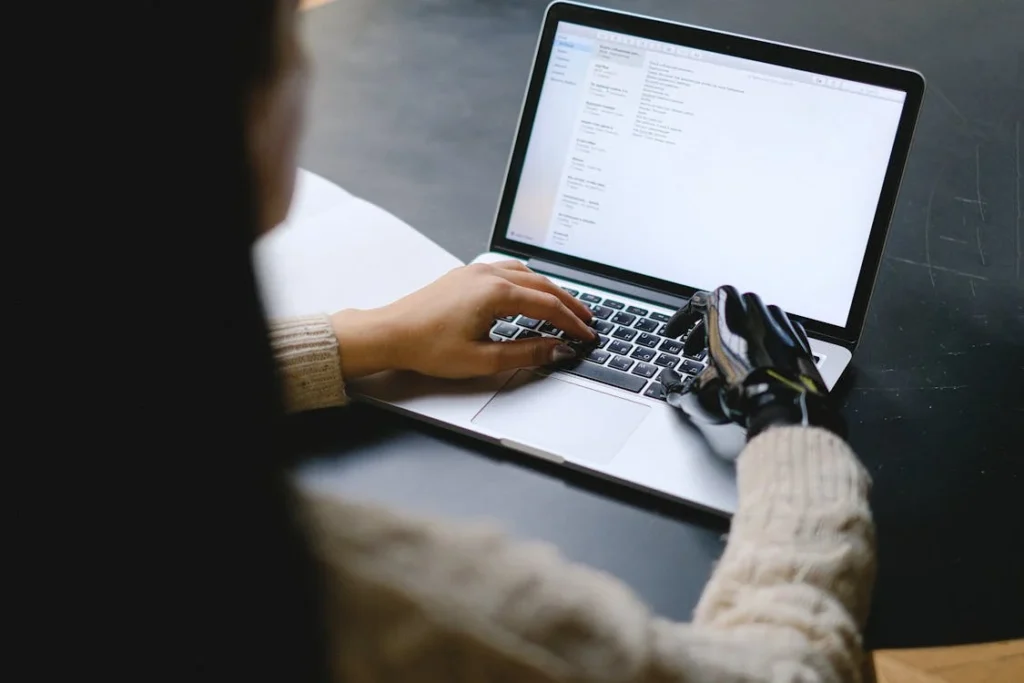
Rebuilding Body Awareness Through Gamified Movement
Understanding Proprioception and Its Role in Coordination
Proprioception is your body’s ability to sense where it is in space. It’s what helps you walk in a straight line without looking at your feet, or reach behind your head to scratch an itch. This “sixth sense” tells your brain how your limbs are moving, even when your eyes are closed. It’s essential for balance, for controlled movement, and for preventing injury.
After limb loss, especially when using a prosthetic, this sense is disrupted. You may no longer receive feedback from nerves or muscles in the missing limb. You may not feel where your new artificial limb begins or ends. The brain becomes unsure of where the body is in space—and that makes coordination extremely difficult.
This is why many new prosthetic users feel clumsy, unbalanced, or disconnected from their body. They’re not just learning a new tool—they’re trying to feel a part of themselves again. And that’s where gamified rehab becomes a quiet but powerful teacher.
How Games Reconnect the Brain With Movement
Gamified rehab offers more than visual stimulation. It gives users a full-body feedback loop. When you move a part of your body and something happens on screen, your brain starts mapping that movement again. It begins to understand: “When I shift this way, something changes.” Even if the prosthetic itself doesn’t provide direct sensation, the visual and auditory response creates a proxy for that lost input.
Over time, that proxy becomes real enough to reshape the brain’s map of the body. This process is called sensorimotor integration. It’s how the brain learns to make sense of what it sees, hears, and does. The more consistent the feedback, the stronger the body awareness becomes.
For example, a user playing a reaching game begins to “feel” how far their prosthetic arm can go—not because of touch, but because of the way their brain matches screen feedback with shoulder movement. Eventually, this awareness becomes instinct. They don’t need to look or think as hard. The motion becomes smooth, confident, natural.
Restoring Balance Through Sensory Reinforcement
Balance isn’t just about strength. It’s about feedback. Your brain uses input from your feet, joints, eyes, and inner ears to figure out where your center of gravity is. When one or more of these signals are missing or altered—as in the case of a lower-limb amputation—your sense of balance becomes unstable.
Gamified rehab can restore this stability. Games that ask the user to shift weight, balance on one leg, or react to moving targets are constantly feeding the brain with new sensory data. With each attempt, the brain recalibrates. It learns how to interpret pressure, motion, and positioning all over again.
And because these tasks are visualized on a screen, the user sees when they’re centered and when they’re off. That immediate feedback is what rebuilds control—not just for standing still, but for walking, climbing stairs, or reacting quickly to uneven ground.
This kind of training is especially effective for elderly users or those who may have other conditions affecting balance, like neuropathy or diabetes. Traditional therapy may not give them the real-time feedback they need—but gamified systems do, and in a way that feels safe and engaging.
Training Movement Without Overthinking It
One of the hidden problems in rehab is overthinking. After an injury or surgery, people often try to manually control every single motion: “Now lift the arm. Now flex the elbow. Now hold.” This conscious control slows everything down and leads to stiff, unnatural movement.
Gamified rehab removes that barrier by drawing attention away from the mechanics and toward the task. When the user is focused on catching a falling object, they’re not thinking about elbow angles. They’re just doing. That shift from conscious control to intuitive response is what proprioception is all about—letting your body do what it knows how to do.
Over time, this creates something that feels like grace: movements that are fluid, instinctive, and integrated. And that’s when real progress happens—when the user stops thinking like a patient and starts moving like themselves again.
Conclusion
Gamified rehab is more than a digital twist on traditional therapy—it’s a complete rethinking of how we help the brain and body heal together. By combining purposeful play with real-time feedback, it sharpens cognitive focus, strengthens coordination, and rebuilds body awareness in a way that feels natural, not forced.
For prosthetic users, especially those recovering from limb loss, this approach offers more than physical improvement. It restores confidence, re-engages the senses, and helps users trust their movements again. Every sound, every visual cue, every challenge is carefully designed to reconnect the brain with the body—and to make the journey feel empowering.
At Robobionics, we’ve seen how this model transforms rehab from something users have to do into something they want to do. And when that shift happens, everything changes.
Because when rehab becomes a game, healing becomes a habit. And with every level passed, every session completed, users aren’t just recovering—they’re rebuilding who they are, one focused movement at a time.



